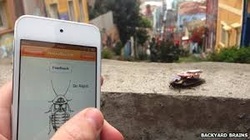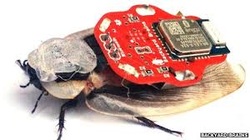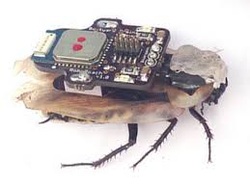 www.bbc.co.uk
www.bbc.co.uk Here's the cruel part. For the electronic backpack to work, the cockroaches have to be placed in icy water to subdue them before sandpaper is used to remove the waxy coating on the shell of the insect's head. An electrode connector and electrodes are then glued on to the insect's body and a needle is used to poke a hole in their thorax in order to insert a wire. Their antennae are then cut and electrodes are inserted. A circuit is attached to their backs, and signals are received through a mobile phone app allowing users to control the cockroaches' movements to the left and to the right.
 www.bbc.co.uk
www.bbc.co.uk The lifespan of a cockroach depends greatly on the species, with some living a matter of months and others surviving for years. New research suggests that, just like humans, they share their recommendations of the best food source. Cockroaches can eat just about anything, and can survive without food for long periods of time, which makes them scavengers.
The Natural History Museum tells us there are about 4,600 species of cockroach and fewer than 30 of these are considered pests. (There are about 5,400 species of mammals). The world's smallest cockroach is only 0.3mm long and lives in ant nests. The heaviest cockroach is the huge Australian Rhinoceros Cockroach at 8cm in length.
 www.independent.co.uk
www.independent.co.uk The miracle drug can cure a number of ailments and they work faster than other medicine. Some Chinese hospitals use a cream made from powdered cockroaches as a treatment for burns and in Korea they use it for cosmetic facial masks. A syrup invented by a pharmaceutical company in Sichuan promises to cure gastroenteritis, duodenal ulcers and pulmonary tuberculosis.
Whichever way you look at it, humans are using cockroaches for their own ends.

 RSS Feed
RSS Feed






